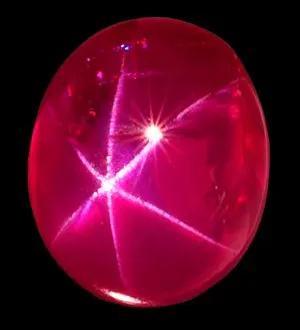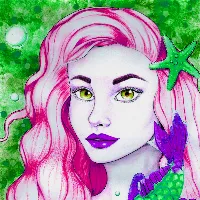On the Moh's Scale, diamond is rated the hardest material, at a solid 10. A few other minerals come in at 9.5, but do not lend themselves to being made into gemstones, except perhaps Moissanite, which can be lab-synthesized and was introduced to the jewelry market in 1998. As far as naturally-occurring minerals that make fine gemstones, corundum is next after diamond, at 9 on the Moh's Scale.
Corundum is an aluminum oxide with the chemical formula: Al2O3. As with other minerals, sometimes other elements can be present, which cause variations in color.
If chromium is present in aluminum oxide stones, they turn red and are called rubies. The most prized rubies are those from Myanmar (formerly called Burma) which are a very particular shade of red with violet-undertones, often called "pigeon blood" red.
The presence of other elements can cause corundum to appear blue and those stones are referred to as sapphires. In fact, any color corundum besides red is called a sapphire, whether blue, pink, yellow, etc., although blue is the most common color besides red.
I have several pieces of ruby which I have acquired over the years. None of them have been terribly expensive, but only USD $10 to $30 or so apiece, and my collection has slowly come together over many years.
The above stone is a raw ruby from my collection. It is shown next to a US penny, for size comparison. I say "raw" because this stone has been extracted from the mine, but has not been cut or polished in any way to turn it into a gemstone. Although the reddish color is not outstanding (as would be in a cut gem), it is still obvious if one looks very closely.
Another raw ruby piece I have is the one shown below. It is much larger than the other one and has a much more substantial feel in the hand. Although the outside looks rough, it is quite smooth to the touch and is wonderful to hold.
All natural rubies have imperfections in them, including color impurities and inclusions of rutile needles known as "silk". Gemologists use these needle inclusions found in natural rubies to distinguish them from synthetics, simulants, or substitutes. [source]
Sometimes when the "silk" is aligned just right, it can reflect light in a shiny patch that can move-about as the stone is turned. The bottom of this ruby has been polished and displays a shiny patch of chatoyancy when the stone is turned. Chatoyancy, by the way, is the same effect seen in Tiger's Eye, Hawk's Eye, and some other stones, which I will show in future posts.
Some rubies and sapphires, if the "silk" rutile inclusions are aligned just right, can display what the lapidary industry calls an asterism — a star-like pattern with either three or six rays. Such a stone is called a "star ruby." As the piece is turned under the light source, the star pattern will appear to move around on the stone. The asterism will only appear on opaque stones, and usually only those cut en cabochon (with a polished, domed top). It takes a skilled, expert eye to determine just where to cut, and how to polish, to make the asterism visible and shown to its best advantage.
Other stones can also display a star, such as Black Star Diopside. I have one of those, too, which I will be photographing and including in a future post.
Even though this ruby of mine only displays a shiny patch of chatoyancy and not a full asterism of a star, it was still marked in the shop as a "star ruby" and I stood there playing with it for a long time trying to see the star. When I asked the shop owner about it, she said that her supplier had presented it to her as a "star ruby" under the claim that any ruby that displayed either an asterism or chatoyancy could be called a "star" ruby. I'm not sure if that is acceptable or not, but there certainly was no intent to defraud anyone, as it could easily be examined by anyone prior to purchase.
SIDE NOTE: Anyone who lives, or travels, to the Orlando, Florida (US) area, should really consider visiting the shop where I purchased this stone: Avalon for a lovely shopping experience with truly beautiful & unique items!
Another ruby that I have is a nice hunk that has been cut and polished smoothly in irregular facets all around. It is a most unusual piece!
This is a very dark stone, but there are places where one can gaze a little ways into it and see the red, gemmy goodness inside with the right lighting conditions! This freeform piece is also quite unique, as I have never seen another stone cut in such a way; this only adds to the specialness of it.
SIDE NOTE: This beautiful ruby crystal was also acquired in the Orlando, Florida (US) area, at a shop called Spiral Circle and is one of the most amazing shops! Definitely visit there if you are in the area!
Not only was the above ruby unusual in its being cut in a unique way, but so is the following piece, too, which I ordered from a vendor on eBay many years ago. Normally, opaque stones are not cut with many facets as are diamonds — that is usually reserved for translucent and transparent stones. This one, however, has been cut in the classic "oval brilliant" style as might be applied to a diamond or a clear ruby.
I had considered having this stone mounted in a pendant so I could wear it, but have not done so yet. I have another ruby pendant, already, and this one would be best shown-off in a custom setting, which would be rather expensive. Perhaps, some day... until then, I will enjoy my present ruby pendant, which I will show in my next post.
Besides appearing as separate crystals, ruby can sometimes be found embedded in other stones. As an example, the following photo shows beautiful bits of microcrystalline ruby (i.e., where the ruby crystals are too small to be seen with the eye) trapped in a bed of green zoisite. Officially, "ruby in zoisite" is known as anyolite, but few people besides professional gemologists use that term. The black bits are pargasite, another mineral that often appears in zoisite and is often misidentified as tschermakite.
Stay tuned for more rubies in PART 2!
SOURCES 1 Wikipedia: Anyolite 2 Wikipedia: Cabochon 3 Wikipedia: Corundum 4 Wikipedia: Moissanite 5 Wikipedia: Ruby 6 Wikipedia: Zoisite

Barbeque & Amethysts • Salt Lamps • Trilobite • Arrowhead
Garden Quartz, freeform • Granite Quarry № 2 • Apophyllite
Rocks from Space! • Quartz Rock: Raw versus Polished
Chrysocolla • Tourmaline • Bornite • Goethite • Small Quartz Crystal
Smoky Quartz • Tibetan Quartz • Amazonite Beads • Zoisite
Rutilated Quartz • Garnet • Amazonite Sphere • Lapis Lazuli Mala
Amethyst Point • How Rocks Get Their Color • Red Jasper
Ring, Ring! Amethyst Calling! • Lapis Lazuli • Turitella Agate


 to learn more about either of these projects, please visit: @heyhaveyamet or @steemterminal
to learn more about either of these projects, please visit: @heyhaveyamet or @steemterminal03-Dec-2019
Return from Ruby – Part 1: Crystals to 𝕜𝕚𝕥𝕥𝕪's Web3 Blog


